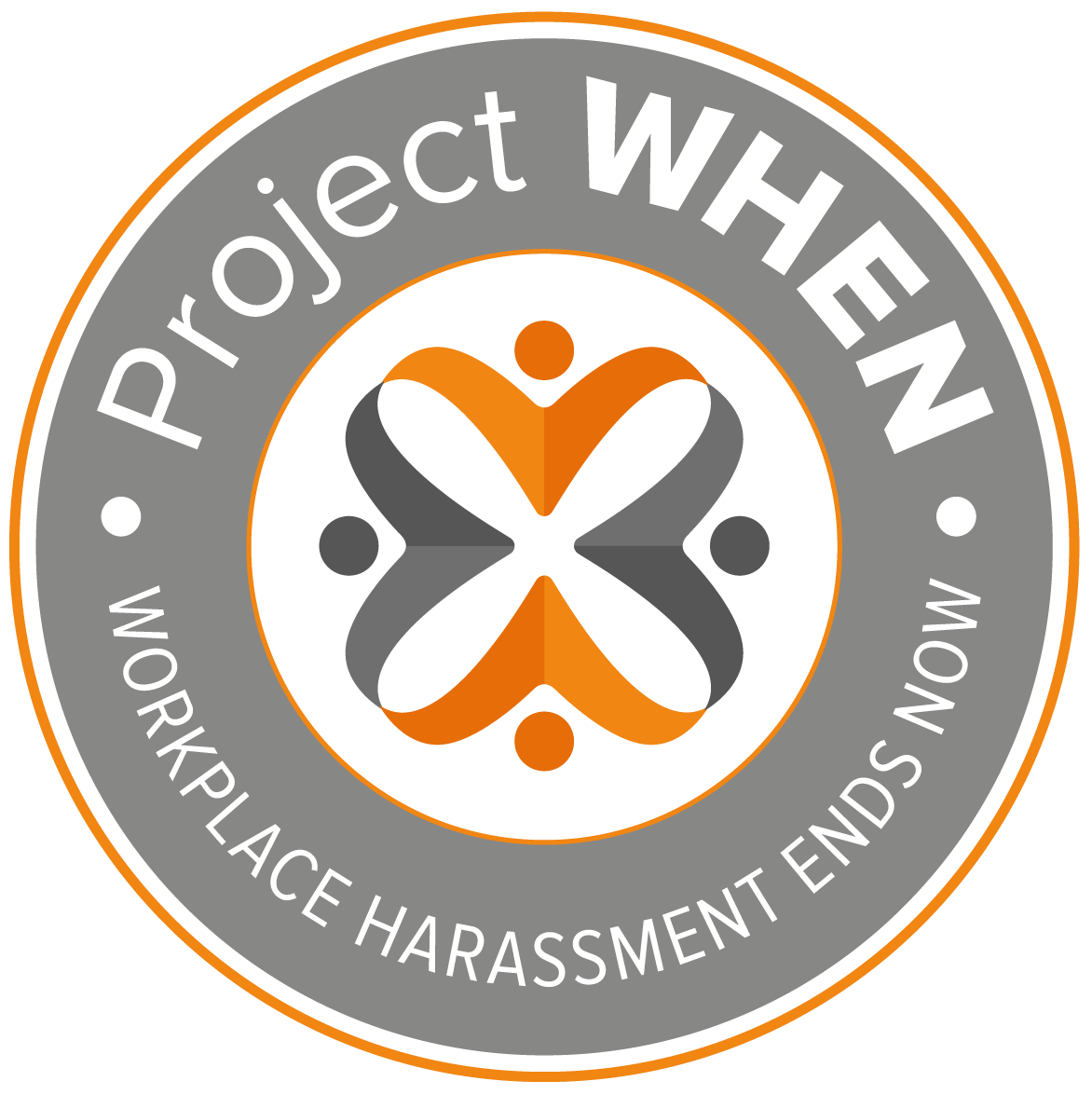Online harassment in the workplace
Many people anticipated that workplace harassment would be reduced now that so many people are working remotely full time or in a hybrid situation. However, to the surprise of many human resources professionals, the opposite has occurred.

If you’re active online, there’s a possibility that one day you could find yourself on the receiving end of hate mail, threats, lewd images, or just garden-variety insults. – Danielle Abril and Heather Kelly, Washington Post
Project WHEN’s definition of harassment is “unwanted conduct to include all areas of workplace harassment, including sexual and physical harassment, quid pro quo harassment, microaggression, bullying, ageism, job shaming, verbal threats, derogatory comments, discriminating or exclusionary behavior, and other forms of offensive behaviors.”
Many unwelcome behaviors can occur regardless of whether the victim is in a physical office or working at home. The examples used by Abril and Kelly share the online tools that perpetrators may use to harass other people.
Project WHEN (Workplace Harassment Ends Now) uses the term “outside the walls of the workplace” to describe the work environment that extends beyond the corporate office. The term ‘workplace’ increasingly refers to an individual’s home-based office or workspace. And, the computer used in that space can be considered an extension of the person using it, whether during regular business hours or outside of the typical workday.
Recent years have shown that workplace harassment can occur outside of a physical office. This is often referred to as online harassment or cyberbullying.
What is online harassment or cyberbullying?
This is a form of harassment that takes place over digital platforms – emails, social media, messaging apps, forums, etc. The major factor in getting cyber bullied is when it occurs publicly, albeit digitally. People send, post, or share negative, insulting, and harassing words to and about someone, with the goal of making someone feel attacked and embarrassed.
Cyber harassment is a difficult thing to endure, especially for victims, because, for one, the digital world is accessible to all, and content put out is available 24 hours, difficult to remove, causes a negative reputation, and at times, difficult for people in authority to monitor and manage.
Online harassment is different from physical harassment only through the medium that it occurs. While physical harassment typically occurs in person, like in the workplace, online harassment, on the other hand, happens in a virtual space.
However, this does not mean online harassment is less evil and emotionally damaging to victims. In fact, some people are victims of in-person harassment first, wherein their abusers take the harassment to the extreme and also bully them online.
For those in the public eye, online harassment has become an expected nuisance and is usually rooted in political or social differences and typically bubbles up via the angry masses on the other end of the spectrum to where these victims stand.
Conversely, in many other instances, cyberbullying tends to be extremely personal and often comes from people the victim knows in real life. Even if the cyberbullying takes place by what appear to be anonymous accounts online, it stands to reason that we spend most of our days at work, and as such, the workplace is the largest pool we have for potential cyberbullies.
Read this The Guardian article about instances of cyberbullying even at work:
https://www.theguardian.com/careers/2017/mar/30/cyberbullying-in-the-workplace-i-became-paranoid
Types Of Cyber Harassment
How do you know and identify cyberbullying? These types take similar forms to the types of bullying that occur offline. It can take the form of any or all these types: hate speech, online sexual harassment, doxing (revealing private information online), impersonation, or identity theft, among others.
How to Avoid Becoming a Victim of Online Harassment
While it is normal to expect some level of vulnerability online, it does not mean there are no ways to keep yourself secure from possible online harassment. Here are a few things you can do to avoid becoming a victim of online harassment:
- Read the security features of the apps you use online, and activate them. Apps are required to have security settings that you can activate when you decide to download and use them. Safety features include limiting who can access your profile, turning on filters to avoid seeing topics or images that you find uncomfortable, blocking or reporting accounts that send or post inappropriate content, and setting your account to private mode so only the people you truly know can access your accounts.
- Use 3rd party apps that add security to your online accounts.
- Avoid talking about personal information and sharing photos that could put you or your loved ones in a vulnerable state online. This particularly involves oversharing things like mobile numbers and email addresses and sharing your location.
- Delete your history when you input them, especially on a public device or public connection, such as at cafes and public wi-fi areas.
- Avoid clicking on spam links.
In the event that someone starts to harass you online, document everything. Take screenshots, and save the messages, numbers, and any important information you can find that can prove that the harassment took place. This will be essential so you have the right evidence when you report their activities to authorities for online harassment and cyberbullying.
Reporting Cyberbullying
Cyber harassment has become rampant, but there is little to no attention given to these things, especially in the workplace setting.
This makes it important for companies that implement remote work to place policies that protect their employees and their business from any form of online harassment.
This report from SHRM breaks down how Human Resources can and should handle online harassment in the workplace: https://www.shrm.org/resourcesandtools/hr-topics/technology/pages/what-hr-can-do-about-cyberbullying-in-the-workplace.aspx
Reporting to HR is a crucial step when it comes to cyberbullying in the workplace. This also places a significant responsibility on employers, especially the human resources division, to ensure that they have active policies in place for situations like this in the organization.
Another way to proactively protect yourself against cyberbullying is to flag the messages as inappropriate so that the social media network or website will be informed and can take appropriate actions on their end. Most social networking sites already have reporting options in place for situations like this. Maximizing these features can help protect users in the long run as developers find more ways to combat cyberbullying from the standpoint of website creators.
All states already have laws in place that deal with cyberbullying. While these rules focus mostly on other forms of cyberbullying and very little on company or workforce cyberbullying, learning these rules would be an excellent start for organizations to create their own laws against workplace online harassment.
If you are the victim of workplace harassment or a witness to it, here is how you can report it:
https://projectwhen.org/resources/how-to-report-workplace-harassment-incidents/
Productivity Loss Due to Harassment
Why should your company care about reducing workplace harassment? The obvious, logical reasons to take action are legal and financial. But what about maintaining or increasing productivity? It is quantifiable.
There is value in avoiding the lost productivity that can occur in toxic work environments. Workplaces, where harassment occurs, lead to disruption of employees’ daily work.
For example, think of the amount of time that one individual may be distracted from their tasks by inappropriate behaviors of co-workers. Let’s say that person works a 40-hour week and loses five minutes of productivity per hour.
The disruption of working in such an environment continues for over two months. They accumulate 40 hours–or one entire workweek–of lost productivity over that period. Chances are, the typical company does not have simply one person who becomes distracted from their work due to harassment in the workplace, and harassment, unfortunately, often goes on much longer than 60 days.
| 5 minutes of distraction per hour x 8 hours per day = 40 minutes of lost productivity per day |
| 40 minutes x 60 days = 2,400 minutes |
| 2,400 / 60 = 40 hours of lost productivity, or a total loss of one week’s work |
Measurable results in productivity can be realized when employees can focus directly on the tasks they are responsible for when they feel respected, have pride in the organization, and find purpose in their work.
Read the Washington Post article to learn Abril and Kelly’s tips to protect yourself from online harassment. Source Link:
washingtonpost.com/…/online-harassment-checklist
How does Project WHEN help?
Project WHEN is working hard to spread the important message and encourage organizations to create a more respectful work culture. While we believe that awareness is important, having a means to directly help victims of harassment would have a huge impact. It is why in addition to expanding our resources for companies and employees, we are working on establishing a victim support hotline.
We aim to offer support to victims by connecting them with someone who can guide them through what they can do to address the problem while being a pillar of emotional support. Our hope is to widen our reach and let everyone know that workplace harassment needs to end now, and if this is something one is battling, help is available.
If you find value in this cause, consider supporting us by making a financial donation to help us further our work. As a 501(c)(3) nonprofit, we rely on financial support from corporations and individuals to enable us to continue our critical mission of making workplaces more respectful everywhere. Donations made to us are tax-deductible.
Want to know about other ways that you can support us? Visit the following link to see how you can get involved with Project WHEN.
About Project WHEN
Diane Stegmeier is the founder and CEO of Project WHEN (Workplace Harassment Ends Now), a 501(c)(3) nonprofit organization dedicated to preventing harassment in the workplace through research, education, corporate and professional certifications, and actionable resources. It’s all about creating respectful, harassment-free workplaces for future generations.


